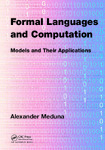Please use this identifier to cite or link to this item:
http://lib.hpu.edu.vn/handle/123456789/21146Full metadata record
| DC Field | Value | Language |
|---|---|---|
| dc.contributor.author | Meduna, Alexander | en_US |
| dc.date.accessioned | 2016-06-10T08:30:18Z | |
| dc.date.available | 2016-06-10T08:30:18Z | |
| dc.date.issued | 2014 | en_US |
| dc.identifier.isbn | 9781466513457 | en_US |
| dc.identifier.isbn | 1466513454 | en_US |
| dc.identifier.other | HPU1160007 | en_US |
| dc.identifier.uri | https://lib.hpu.edu.vn/handle/123456789/21146 | - |
| dc.description.abstract | Formal language theory defines languages mathematically as sets of sequences consisting of symbols. This definition encompasses almost all languages as they are commonly derstood. Indeed, natural languages, such as English, are included in this definition. Of course, all artificial languages introduced by various scientific disciplines can be viewed as formal languages, perhaps most illustratively, every programming language represents a formal language in terms of this definition. It thus comes as no surprise that formal language theory, which represents a mathematically systematized body of knowledge concerning formal languages, is important to all the sientific areas that make use of these languages to a certain extent. | en_US |
| dc.format.extent | 310 p. | en_US |
| dc.format.mimetype | application/pdf | - |
| dc.language.iso | en | en_US |
| dc.publisher | CRC Press | en_US |
| dc.subject | Formal languages | en_US |
| dc.subject | Computation | en_US |
| dc.subject | Models | en_US |
| dc.subject | Applications | en_US |
| dc.title | Formal languages and computation: Models and their applications | en_US |
| dc.type | Book | en_US |
| dc.size | 3,734KB | en_US |
| dc.department | English resources | en_US |
| Appears in Collections: | Technology | |
Files in This Item:
| File | Description | Size | Format | |
|---|---|---|---|---|
| 7_FormalLanguages_and_Computation_Models.pdf Restricted Access | 3.73 MB | Adobe PDF |  View/Open Request a copy |
Items in DSpace are protected by copyright, with all rights reserved, unless otherwise indicated.
